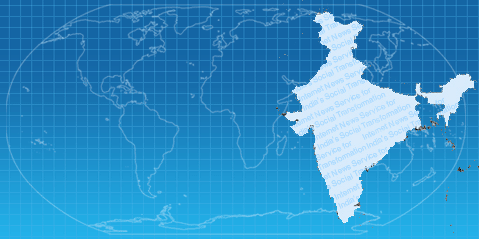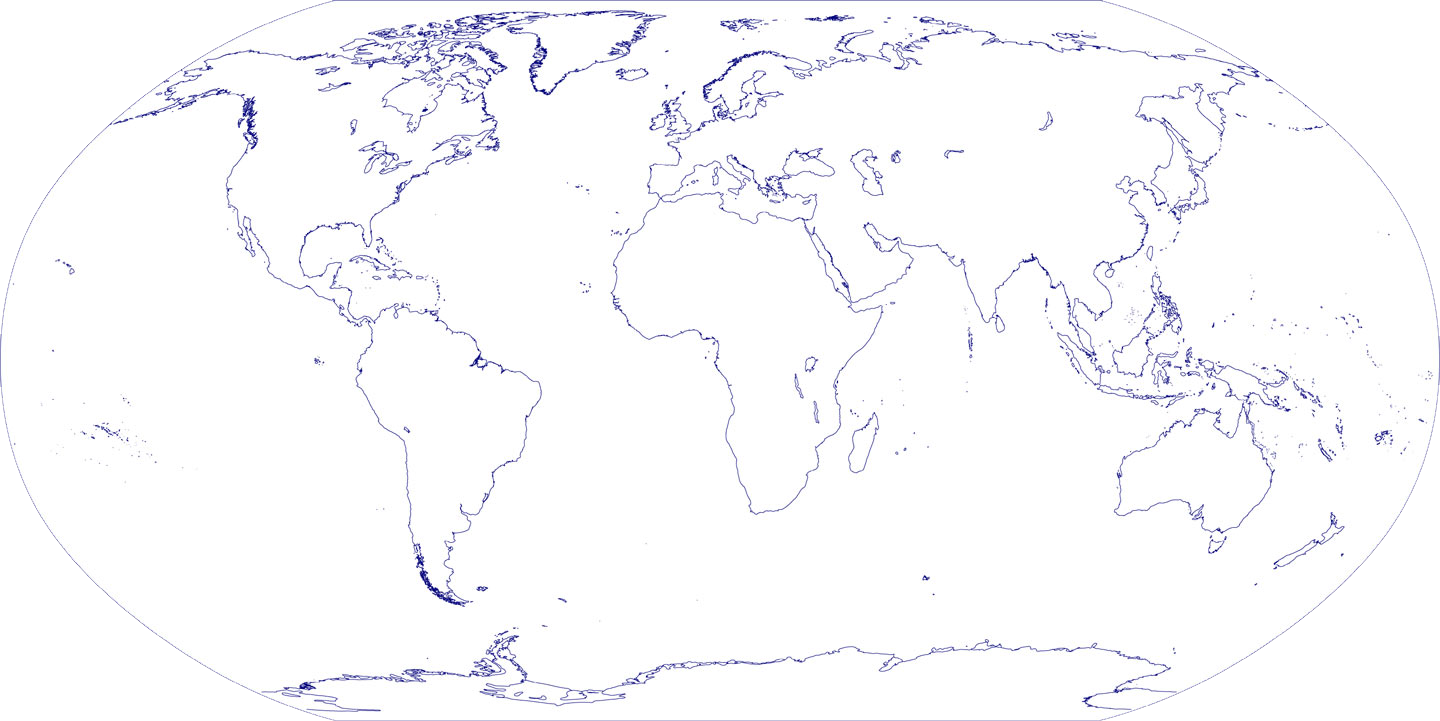
The following are the
categories of news and views to be sent to us :
Categories
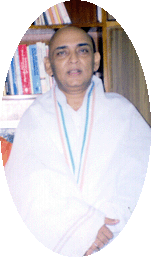
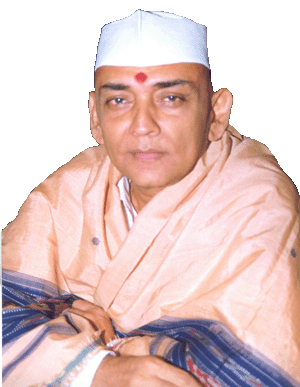
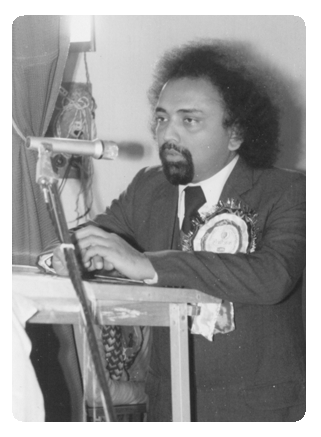
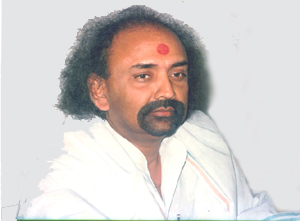



|
Internet News Service for India's
Social Transformation (INSIST)
has been established by leading intellectuals,
social scientists, policy makers and educators with a view to
propagating news relevant to education and national
development. Different types of news, notifications and releases
are put on this
website.
Click any news
Ziro, Arunachal Pradesh :
21 February 2023 |
DOCTOR OF PHILOSOPHY (Ph.D.) COURSE 2023
BATCH LAUNCHED BY INDIRA GANDHI TECHNOLOGICAL AND MEDICAL
SCIENCES UNIVERSITY, ZIRO, ARUNACHAL PRADESH |
|
|
|
|
New Delhi (India) : 25 February 2022 |
2021 INDIAN UNIVERSITIES DIRECTORY AND
HANDBOOK GETTING RELEASED ON THE OCCASION OF THE WORLD CONSUMERS
RIGHTS DAY ON 15 MARCH 2022 |
|
|
|
|
29 September 2020, Huntsville, Alabama, USA |
IAEWP TO LAUNCH FREE ONLINE AWARENESS
COURSES ON PEACE, DISARMAMENT, SPIRITUALITY, INTERFAITH STUDIES
Etc. |
|
|
|
|
New Delhi, June 5, 2020 |
The
Indian Institute of Applied Agriculture (IIAA) has launched the
following Certificate Courses in different areas related to
agriculture and allied subjects. |
|
|
|
|
New Delhi, May 11, 2020 |
Dr.
PRIYA RANJAN TRIVEDI IS PIONEER IN PERCEIVING THE ROLE OF
COMPUTERS IN GOVERNMENT |
|
|
|
|
New Delhi, June 5, 2020 |
WORLD INSTITUTION BUILDING PROGRAMME
(WIBP) OBSERVES ITS 46th ANNIVERSARY AND ANNOUNCES THE 450-POINT
PROGRAMMES, PRINCIPLES AND PRACTICES OF INSTITUTION BUILDING AND
DEVELOPMENT |
|
|
|
|
New Delhi, June 5, 2020 |
The 40th Anniversary of the Indian
Institute of Ecology and Environment (IIEE) Observed and
Celebrated on 5th June 2020
|
|
|
|
 |
15
VOLUME WORLD ENCYCLOPAEDIA OF ECOLOGY AND
ENVIRONMENT RUNNING INTO MORE THAN 8000 PAGES
RELEASED FOR THE BENEFIT OF SCHOOLS, COLLEGES AND
UNIVERSITIES |
|
|
|
|
New Delhi, June 5, 2019 |
Dr. Priya Ranjan Trivedi presents First
Atal Bihari Vajpayee Memorial Lecture on Environment on the
occasion of World Environment Day 2019
|
|
|
|
|
Ziro, November 1, 2018 |
dr.
mridula saikia khanikor appointed as the new vice chancellor of
indira gandhi technological and medical sciences university
ziro, aruanchal pradesh on November 1, 2018
|
|
|
|
|
Ziro, November 1, 2018 |
IGTAMSU SPONSORED REGIONAL MEET ON WOMEN,
NURSING AND ENVIRONMENT INAUGURATED BY
RGU VICE CHANCELLOR Prof. saket kushwaha |
|
|
|
|
Ziro, 27th September 2018 |
IGTAMSU TEAM MEMBERS MEET THE HON’BLE EDUCATION MINISTER OF
ARUNACHAL PRADESH
Mr.
Honchun Ngandam AT
ITANAGAR |
|
|
|
|
Ziro, 27th September 2018 |
IGTAMSU TEAM MEMBERS CALL ON THE HON’BLE
CHIEF MINISTER OF ARUNACHAL PRADESH Mr. PEMA KHANDU |
|
|
|
|
Ziro, 26th
September 2018 |
Dr.
Markandey Rai and Dr.
Utkarsh Sharma appointed as IGTAMSU’s
Chancellor and
Pro Chancellor respectively
|
|
|
|
|
New Delhi, 2nd
September 2018 |
First
Awareness-cum-Treatment Camp of the World Association of
Auricular Therapy
organised at New Delhi on 2nd
September 2018 |
|
|
|
|
New Delhi, 27 August 2018 |
WORLD ASSOCIATION OF AURICULAR THERAPY
(WAAT) INCORPORATED AS AN INTERNATIONAL CHARITY AT NEW DELHI |
|
|
|
|
New Delhi, 5 June 2018 |
Book titled "the challenges of 21st
century" authored by
Dr. markandey rai
released during national environment convention 2018 by union
ministers
shri suresh prabhu and
Dr. JITENDRA SINGH
|
|
|
|
|
New Delhi, 15 March 2018 |
Book on Rashtriya Swayamsevak Sangh authored by dr.
P. R. Trivedi presented to hrd minister of india shri prakash
javadekar |
|
|
|
|
New Delhi, 15 March 2018 |
12 VOLUME INTERNATIONAL
ENCYCLOPAEDIA OF DISASTER MANAGEMENT RELEASED BY HRD
MINISTER OF INDIA SHRI PRAKASH JAVADEKAR |
|
|
|
|
New Delhi, 23 May 2018 : |
THE GLOBAL OPEN UNIVERSITY NAGALAND (TGOUN) GETS
BEST UNIVERSITY AWARD IN THE FIELD OF CURRICULUM
DEVELOPMENT AND INSTRUCTIONAL MATERIAL PREPARATION |
|
|
|
|
New Delhi, May 1, 2018 |
national
environment convention 2018 to be held under the
joint auspices of iiee and nicer on 5-6 june 2018 at
new delhi |
|
|
|
|
New Delhi, May 15, 2018 |
Seychelles to get full support for
establishing virtual university besides an
international centre on environment |
|
|
|
|
Patna, 12 February
2018 |
Book on
RSS authored by Dr. Priya Ranjan Trivedi and Dr.
Bipin Kumar gets released by Dr. Mohan Bhagwat,
Sarsanghchalak of RSS |
|
|
|
|
New Delhi, May 1, 2018 |
PACKAGE ANNOUNCED FOR IMPROVING THE
FINANCIAL, ACADEMIC AND INFRASTRUCTURAL HEALTH OF
UNIVERSITIES IN INDIA on 8 March 2018
at New Delhi |
|
|
|
|
New Delhi, March 1, 2018 |
World Women Summit 2018 to be held on 8 March 2018
at New Delhi |
|
|
|
|
New Delhi, 02 November 2017 |
The President Chancellor Dr.
P. R. Trivedi of 2017 World Management Congress
declares "Management of National Developement" as
the theme for the Congress to be held on 21-22
December 2017 at New Delhi www.congress.ind.in
www.congress.ind.in |
|
|
|
|
New Delhi, 11 October 2017 |
THE BOOK
TITLED “THE LADY DIVINE : A PICTORIAL AND DIDACTICAL
BIOGRAPHY OF HER HUMBLENESS NISHA JEEWACHH TRIVEDI”
DEDICATED TO THE WORLD CITIZENRY ON THE OCCASION OF
THE INTERNATIONAL DAY OF THE GIRL CHILD ON 11TH
OCTOBER 2017 |
|
|
|
|
New Delhi, 3 October 2017 |
National Environmental Skills
Development Summit 2017 |
|
|
|
|
New Delhi, 2 August 2017 |
World Education Convention to
be held on 5-6 September 2017 will be organised by
Afro-Asian- American Chamber of Commerce,
Occupational Research and Development (ACCORD)
|
|
|
|
|
New Delhi, 11 July 2017 |
controlling population size is the best way to
ensuring women’s empowerment – Meenakshi Lekhi
(2017
World Women’s Empowerment Summit Inaugurated on 11
July 2017) |
|
|
|
|
New Delhi, 28 April 2017 |
World
women's empowerment summit to be held at new
Delhi
on 11 July 2017 |
|
|
|
|
New Delhi, 25 April 2017 |
World clean environment summit
2017 to be held on
5-6 june 2017 at new delhi |
|
|
|
|
New
Delhi, 19 January 2017 |
2017 World Girl Child Education and Empowerment Summit to be held on
8 March 2017 under the aegis of Women's Agency for Generating Employment |
|
|
|
|
8 March 2017, New
Delhi |
International Women's Day Observed by Women's Agency
for Generating Employment (WAGE) |
|
|
|
|
17 January 2017 |
Skill and Vocational Education
(SAVE) Day |
|
|
|
|
Patna, 22 December 2016 |
Hindi Edition of Cleanliness
Manual and Handbook Brought out for Strengthening
“Lohia Swachchh Bihar Abhiyan” released by the Urban
Development Minister of Bihar Shri Maheshwar Hazari |
|
|
|
|
New Delhi, 31 December 2016 |
The World Renowned Environmental Scientist
Dr. Priya Ranjan Trivedi dedicates the
24 Volume World Encyclopaedia of Nanoscience
and Nanotechnology to the world citizenry |
|
|
|
|
New Delhi, 28 December 2016 |
CLEANING
THE IVORY TOWERS : CLEANLINESS RELATED TRACK RECORDS OF UNIVERSITIES
(CIU’s
13th Anniversary to be observed on 12th
March 2017) |
|
|
|
|
New Delhi, January 1, 2017 |
SKILL AND
VOCATIONAL EDUCATION (SAVE) SUMMIT TO BE HOSTED
JOINTLY BY CIU AND NICER AT NEW DELHI ON 12 MARCH
2017 |
|
|
|
|
New Delhi,
12th December 2016 |
UNION
MINISTER OF STATE FOR HEALTH AND FAMILY WELFARE, Ms.
ANUPRIYA PATEL INAUGURATES WORLD CLEANLINESS
CONVENTION 2016 AT NEW DELHI |
|
|
|
|
New Delhi,
1st December 2016 |
2016 world
cleanliness convention to be held at new Delhi on
12-13 December 2016 |
|
|
|
|
New Delhi,
19th November 2016 |
240 Crore people lack access to improved sanitation
facilities all over the world |
|
|
|
|
Darbhanga, dated 5 November
2016 |
Book on Darbhanga released by
Chancellor Dr.P. R. Trivedi for promoting mithila
culture on the world map |
|
|
|
|
Muzaffarpur dated 4 November
2016 |
Book titled "Muzaffarpur :
Past, Present and Future" released by the MLAs
during Chhath |
|
|
|
|
Kolkata, 5 October 2016 -
World Teachers' Day |
Dr.Priya Ranjan Trivedi
Advocates for Creating World Class Universities |
|
|
|
|
New Delhi, October 1, 2016 |
CIU to Celebrate its
12th anniversary on 5th OCTOBER 2016 AT KOLKATA on
the occasion of united nations World teachers day |
| |
|
|
New Delhi, 5 September 2016 |
"G-51" group formeD for
launching cleanliness, hygiene and sanitation
education (chase) with the support of 51
universities of india |
|
|
|
|
New Delhi, 22nd March 2016 |
COSPONSORED BY MORE
THAN 50 UNIVERSITIES, THE NATIONAL INSTITUTE OF
CLEANLINESS EDUCATION AND RESEARCH (NICER) LAUNCHED
DURING THE AFRO-ASIAN CLEANLINESS CONVENTION 2016 |
|
|
|
|
New Delhi, 29th January 2016 |
national institute of cleanliness education and
research (NICER) to clean up india |
|
|
|
|
New Delhi, 18th January 2016 |
geriatric care : the need of the hour for taking
care of the elderly persons |
| |
|
|
Dehradun / New Delhi, 11th December 2015 |
encourage
sustainable development of mountains-Dr.P.R.Trivedi |
|
|
|
|
New Delhi, 5th December 2015 |
World Soil Day Celebrated at Indian Institute of
Applied Agriculture (IIAA, New Delhi |
|
|
|
|
New Delhi, 5th December 2015 |
Voluntary Action and volunteer efforts discussed
during the international volunteer day 2015 |
|
|
|
|
New Delhi, 3rd December 2015 |
15th
Annual Day of the Indian Institute of
Empowerment Celebrated on the occasion of the United
Nations' International Day of Persons with
Disabilities |
|
|
|
|
New Delhi, 1st December 2015 |
World Aids day observed at indian institute of
health |
|
|
|
|
New Delhi, 25th November 2014 |
Book on
prime minister narendra modi released by goa
governor |
| |
|
|
New Delhi, 5 October
2014 |
Books on Kerala and Uttar Pradesh released by the
respective governors on the occasion of the Tenth
anniversary of CIU |
|
New Delhi, 26 November 2014 : The Book
titled "Narendra Modi : The Man India
Needs," authored by Chancellor Dr. P R
Trivedi, President, Confederation of Indian
Universities (CIU) was released by the Goa
Governor Mridula Sinha in a glittering
function attended by many foreign
dignitaries including the Ambassador of
Czech Republic H.E. Miloslav Stasek, the
High Commissioner of Pakistan H.E. Abdul
Basit and the Ambassador of Guatemala H.E.
George de La Roche besides selected 200+
scholars of repute from all over the
country. Releasing the book besides
launching the "Cleanliness, Hygiene and
Sanitation Education (CHASE) Project,
Governor Mridula Sinha stressed the need for
being cleaner, greener and hygienic with a
view to making our country one of the models
in the world.
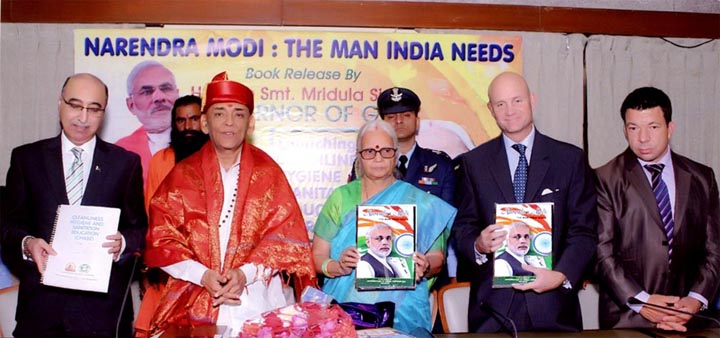
The Governor of Goa Hon'ble Mridula Sinha
releasing the book "Narendra Modi : The Man
India Needs" in the poresence of the author
Dr. P R Trivedi,
Ambassador of Czech Republic H.E. Miloslav
Stasek, the High Commissioner of Pakistan
H.E. Abdul Basit and the Ambassador of
Guatemala H.E. George de La Roche.
Citing the examples from from the holy books
for cleaning oneself before any worship, she
called upon the world citizenry to
learn lessons from the Prime Minister
Narendra Modi who is an ideal example of a
complete and dedicated leader who has thrown
himself for the welfare of the humans living
on this mother earth. She asked the schools,
colleges and universities to implement
"Swachchh Bharat Abhiyan : Clean India
Movement" at the earliest. Cleaning the
atmosphere, rural and the urban areas
besides the human mind should be the topmost
priority.
The book titled "End of Coalition Politics
in Modi Era" authored by Dr. Imotemsu Ao,
Registrar, The Global Open University
Nagaland was also presented to the Governor
on this occasion coinciding with the United
Nations International Day of Elimination of
Violence Against Women. The CIU President
Dr. P R Trivedi announced on this occasion
that his book "Goa : Past, Present and
Future" will be released by the Goa Governor
next year in January in Goa.
|
|
|
New Delhi, 5
October 2014 |
Books on Kerala and
Uttar Pradesh released by the respective governors
on the occasion of the Tenth anniversary of CIU |
|
The Books titled "Kerala : Past, Present and
Future" and "Uttar Pradesh : Past,
Present and Future" were released by the
Governor of Kerala, Justice P. Sathasivam
and the Governor of Uttar Pradesh, Ram Naik
respectively on the occasion of the World
Teachers' Day in a glittering function
organized by the Confederation of Indian
Universities during its 10th
Anniversary in the presence of the
Ambassadors, High Commissioners and
Representatives from Spain, Bolivia, Guinea,
Malawi, Indonesia, and Denmark besides the
National Awardees including the Wrestler
Ramphal and the Devotional Singer Narendra
Chanchal. These Books authored by the Great
Institution Builder and Philanthropist Dr.
Priya Ranjan Trivedi contain all the
relevant information regarding these States
like the history, prehistory, culture,
economy, education, industry, demography,
tourism and infrastructure.
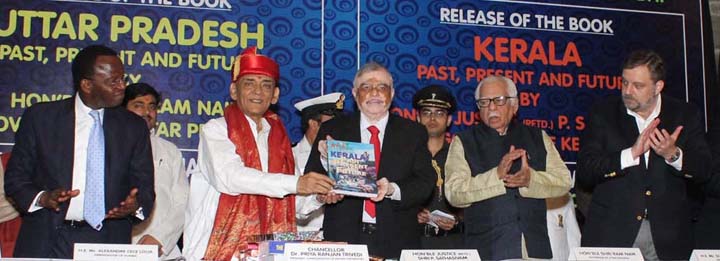
The Kerala Governor Justice P. Sathasivam
releasing the Book "Kerala : Past, Present
and Future" authored by Chancellor, Dr.
Priya Ranjan Trivedi, President,
Confederation of Indian Universities on the
occasion of the World Teachers' Day at New
Delhi on 5th October 2014.
The Governor Justice P. Sathasivam informed
the learned audience that Kerala was the
only State with the lowest positive
population growth rate (3.44%) and having
the highest human development index (0.79%)
in the country. He further added that Kerala
held the highest literacy rate (93.19%)
besides the highest life expectancy (77
years) and the highest sex ratio (1000 men :
1084 women). He also congratulated the
Confederation of Indian Universities (CIU)
for uniting all the 738 Universities of
India for optimizing its available
resources. He wanted everybody to remember
what Dr. Sarvepally Radhakrishnan said about
the university "A University is not a mere
information shop. It is a praised where a
man's intellect, will and emotions are
discipline. In it, experience and adventure
are combined to create a better man".
On this auspicious occasion, another Book
titled "Uttar Pradesh : Past, Present and
Future" getting released by the Governor of
Uttar Pradesh, Ram Naik had many observers
to know more about the most populous State
of India. While releasing this Book, the
Governor Ram Naik said that there are only
five countries namely China, India, USA,
Indonesia and Brazil have the credit of
being more populous then Uttar Pradesh. In
his all comprehensive comments made in Hindi
language, he also said that Uttar Pradesh
has the credit of being the birth place of
the national language : Hindi and that the
ancient culture emerged from Uttar Pradesh
besides the creation of mythological
literature like Ramayana and Bhagwad Gita.
He also congratulated the author Dr. Priya
Ranjan Trivedi for taking great pains in
compiling information regarding all the
Districts of Uttar Pradesh besides the
relevant data regarding the educational
facilities, industrial relations, culture,
sports, economy and demographic details of
Uttar Pradesh.

The Governor of Uttar Pradesh, Ram Naik
releasing the Book "Uttar Pradesh : Past,
Present and Future" authored by Dr. Priya
Ranjan Trivedi in the presence of the Kerala
Governor P. Sathasivam, the Ambassadors and
High Commissioners from Indonesia, Bolivia,
Guinea, Spain, Malawi
on the occasion of the World Teachers' Day
at New Delhi on 5th October 2014.
The Governor Ram Naik also desired that this
publication be widely circulated in the
State of Uttar Pradesh besides the tourists
coming from all over the world for enabling
everybody to know more about the salient
features and the cultural heritage of Uttar
Pradesh. He also invited the international
dignitaries to visit Uttar Pradesh.
The Ambassador of the Kingdom of Spain
Gustavo de Aristegui while detailing the
tertiary education scenario in Spain invited
the Confederation of Indian Universities
(CIU) to visit the different Universities in
Spain for ensuring mutual and technical
cooperation.
The Ambassador of the Plurinational State of
Bolivia Prof. Jorge Cardenas Robes announced
academic tie-ups between India and Bolivia
for international education projects with a
view to implementing action oriented
programmes in both the countries.
The Ambassador of Guinea Alexandre CeCe Loua
wanted educational cooperation between India
and Guinea for reducing the wastage in
education and for solving the burning
problems of the educated youth of India and
Guinea.
The High Commissioner of Malawi Dr. Perks
Ligoya wanted Indian educational experts to
go to Malawi for heading different
Universities for bringing efficiency and
productivity in the tertiary educational
systems as there is a lack of trained
educational man power in Malawi.
The Deputy Ambassador of Indonesia Tito Dos
Santos Baptista wanted India and Indonesia
to further strengthened the educational
protocols for benefiting both the countries
and the present number of students studying
from India and Indonesia by leaving their
countries for better specializations.
The Innovation and Research Counsellor in
the Embassy of the Kingdom of Denmark
Kristoffer Brix Bertelsen expressed hope
that India and Denmark will work together
for quality higher education by exchanging
information between the two countries.
The project "Cleanliness, Hygiene and
Sanitation Education (CHASE)" was also
launched besides the release of the "2014
Indian Universities Directory" running into
800 pages jointly by the Kerala and the
Uttar Pradesh Governors.
The CIU endorsed the charitable work of
"Sarbat Da Bhala" and felicitated its
Founder Sdr. S.P.S. Oberoi. Many
individuals, organizations, principals,
professors and activists were praised for
their outstanding contribution and accolades
were presented to them.
Presently the keynote address the CIU
President Chancellor Dr. P R Trivedi said
that to his mind, the main problems in
almost all States and Union Territories of
the country was relating to peacelessness,
poverty, unemployment, pollution and
population explosion. In order to solve
these problems, the solution could be in
creating more and more jobs by also
preparing a competent cadre of young
professionals equipped with vocational and
skill based knowledge. He further explain
that India will be needing more than 550
million trained persons by the year 2024.
That means, one third of every State's
population will be required to become fully
skilful. Accordingly Uttar Pradesh will have
to produce 85 million skilled persons by the
year 2024 and accordingly 8.5 million
skilled persons every year. He hoped that
the 2100 types of programmes designed by CIU
in different areas related to hospitality,
health care, environmental science, disaster
management, tourism, geriatric care, remote
sensing, bioinformatics, journalism, mass
communication, information technology,
e-governance, good governance will help the
implementing agencies in providing training
and research facilities to the young boys
and girls.
Dr. Trivedi was of the view that while our
country with 1250 million population has
many problems but there are many excellent
possibilities for helping the entire world.
In order to achieve the appropriate targets,
the urgent need is of providing value based
education at the School, College and the
University levels Institutions so that the
movement for character building is speeded
up fastly. There has to be a mass movement
by bringing attitudinal and behavioural
change among the minds of the educators,
teachers, trainers and didactics.
While criticizing regarding the existence of
more than required number of regulations to
control tertiary education,
Dr. P R Trivedi
thanked the Government of India as it has
decided to withdraw many of the old and
obsolete laws, rules, regulations and
statutes as these are making our
developmental process very slow. Same is the
case with education and training. There are
more number of Statutory Bodies dealing with
education which are not required in the
present context. The Universities in India
are responsible as well as autonomous
organisations. They should be given full
freedom to design their curriculum, conduct
classes, prepare instructional materials and
provide necessary support to the students to
either seek jobs or to provide jobs by
throwing themselves into the entrepreneurial
fields, Dr. Trivedi opined.
|
|
New Delhi, 5
September 2016 |
"G-51" group formeD for launching cleanliness,
hygiene and sanitation education (chase) with the
support of 51 universities of india |
|
New
Delhi, 5th September 2016
The "G-51"
the Group of 51 Universities for introducing
Cleanliness, Hygiene and Sanitation
Education (CHASE) has been formed at the
behest of the National Institute of
Cleanliness Education and Research (NICER)
for covering the entire country including
all the States and Union Territories by
launching an online / offline non-formal
Post Graduate level course of one year
duration leading to the Post Graduate
Diploma in Cleanliness, Hygiene and
Sanitation Education (PGD-CHASE).
Announcing
this, the Director of NICER, Shri Utkarsh
Sharma said that the contents of this unique
Post Graduate Diploma include
Introduction to Cleanliness; Hygiene
Concepts; Sanitation Education; Public
Health; Solid and Liquid Waste Management;
Water Quality Monitoring and Surveillance;
Ecological and Environmental Protection;
Project Work and Thesis.
The salient
feature of this programme in order to
strengthen the cause of Swachchh Bharat
Abhiyan is that the 11 Volume World
Encyclopaedia of Cleanliness, Hygiene and
Sanitation Education (WE-CHASE) is presented
to all the admitted participants in the CD
format without any extra charge, Shri
Utkarsh Sharma added.
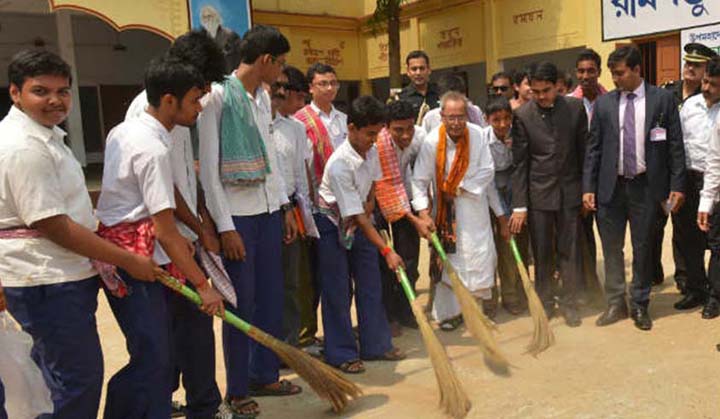
Hon'ble President of India Shri Pranab
Mukherjee participating in the Clean India
Campaign
The
motivation for launching the much needed
vocational and professional programme
related to training in the fields of
cleanliness, hygiene and sanitation
education is based on the cleanliness
movement started by the father of the nation
Mahatma Gandhi followed by many Indian
Leaders before and after independence.
The Swachchh
Bharat Abhiyan initiated by our Hon'ble
Prime Minister Shri Narendra Modi has led
the NICER to show itself into the new
environment with full of zeal and enthusiasm
to ensure that India becomes cleaner as well
as greeners.
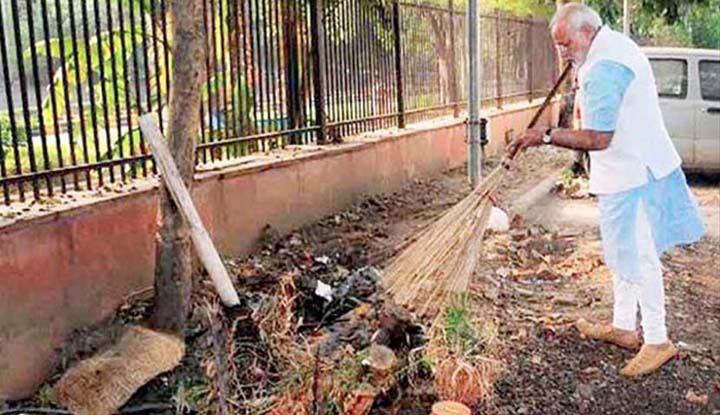
Hon'ble Prime Minister of India
participating in the Swachchh Bharat
Abhiyan.
The Post
Graduate Diploma in Cleanliness, Hygiene and
Sanitation Education (PGD-CHASE) is fully
online although those living in the rural
areas with no facilities of internet may get
the books by post, Shri Utkarsh Sharma
further added.
All the
details regarding admission, curriculum,
monitoring and evaluation etc. are detailed
on the website :
niceronline.com
Highlighting
the torch bearing role of the National
Institute of Cleanliness Education and
Research (NICER), Shri Utkarsh Sharma opined
that the NICER has a master plan to
introduce cleanliness education in all the
800+ universities, 50,000 colleges and 1,5
million schools of our country besides the
collaborative plans to clean up all rivers,
mountains, temples, gurudwaras, mosques,
monasteries, public places, industries,
railways and roadways.
In his
concluding remarks, the Director, NICER,
Shri Utkarsh Sharma hoped that all the Union
Ministers and their Bureaucrats and
Departmental Heads, Governors, Chief
Ministers, Chancellors, Vice Chancellors,
Principals of Colleges and Schools will
immediately contact through the website :
niceronline.com
without any delay for getting benefitted for
acquiring expert skills needed for our
country with a view to mixing skill
development with cleanliness, hygiene and
sanitation.
Shri Utkarsh
Sharma also assured that the services
relating to admission, counseling, guidance,
monitoring and evaluation are the quickest
as the process is automatic via the website
:
niceronline.com
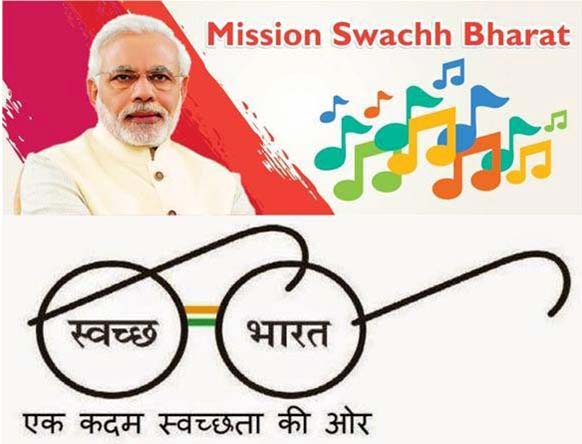
|
|
New Delhi,
October 1, 2016 |
CIU to Celebrate its
12th anniversary on 5th OCTOBER 2016 AT KOLKATA on
the occasion of united nations World teachers day |
|
Press Release
New Delhi, October 1, 2016 (United Nations
International Day of the Elderly Persons)
The Confederation of Indian Universities
(CIU) established and inaugurated on the
occasion of the Higher Education and
Development (HEAD) Day on 15th
April 2004 at New Delhi will have its 12th
Anniversary Celebrations at the Science City
Auditorium, Kolkata where the Governor of
Tripura Hon'ble Prof. Tathagata Roy will be
the Chief Guest. He will also release the
Indian Universities Directory 2016
containing the list and details of more than
835 Universities of our country duly
recognized by the Government of India and
the University Grants Commission (UGC).
Addressing the Representatives of the print
and the electronic media, the President of
Confederation of Indian Universities (CIU)
Dr. Priya Ranjan Trivedi said that many
packages and state of art technologies will
be discussed for the benefit of all the
university level bodies. Main stress will be
given on employment centric cleanliness,
hygiene and sanitation education with a view
to strengthening the cause of Swachchh
Bharat Abhiyan announced by the Hon"ble
Prime Minister Shri Narendra Modi, he
further added.
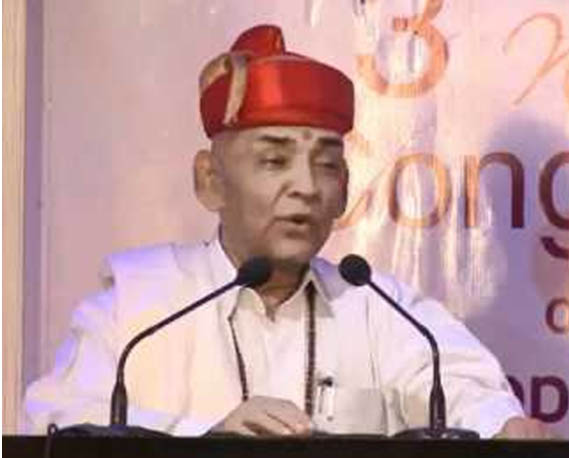
CIU
President Dr. Priya Ranjan Trivedi
addressing the Press and Media
Out of the existing inventory of more than
1000 Chancellors, Vice Chancellors and Heads
of Institutions of National importance,
important personalities to be felicitated
during the 12th Anniversary at
the Science City Auditorium, Kolkata on 5th
October 2016 at 4 pm include Prof. Gurdeep
Singh, Vice Chancellor, Vinoba Bhave
University, Hazaribagh, Jharkhand;
Prof. P K Mishra,
Vice Chancellor, North Orissa University,
Odisha; Prof. Saket Kushwaha, Vice
Chancellor, Lalit Narayan Mithila
University, Darbhanga, Bihar; Dr. Anwar
Shaikh, Director, International Affairs,
Commonwealth, Vocational University, Tonga;
Prof. Basab Chaudhuri, Vice Chancellor, West
Bengal State University, West Bengal;
Prof. Ranjan
Chakrabarti, Vice Chancellor,
Vidyasagar University, West Bengal;
Prof. Gopal
Chandra Misra, Vice Chancellor,
University of Gourbanga, West Bengal;
Prof. Smritikumar
Sarkar, Vice Chancellor, University
of Burdwan, West Bengal;
Prof. Dipak Ranjan
Mandal, Vice Chancellor, Sidho-
Kanho-Birsa University, West Bengal;
Prof. Anuradha
Mukhopadhyay, Vice Chancellor,
Diamond Harbour Women's University, West
Bengal; Prof. Mita
Banerjee, Vice Chancellor, West
Bengal University of Teachers' Training,
Education Planning and Administration, West
Bengal ; Prof.
Chirantan Chattopadhyay, Vice
Chancellor, Uttar Banga Krishi
Viswavidyalaya, West Bengal;
Prof. Anil Bhumali,
Vice Chancellor, Raiganj University, West
Bengal; Prof.
Purnendu Biswas, Vice Chancellor,
West Bengal University of Animal and Fishery
Sciences, West Bengal;
Prof. Dhrubojyoti
Chattopadhyay, Vice Chancellor, Amity
University, West Bengal;
Prof. A. S
Kolaskar, Vice Chancellor, The Neotia
University, West Bengal;
Prof. H N Datta,
Vice Chancellor, The Global Open University,
Nagaland; Prof.
Sunil Rai, Vice Chancellor, Assam
Kaziranga University, Assam;
Prof. J D S Panwar,
Vice Chancellor, Venkateshwra Open
University, Arunachal Pradesh;
Prof. Fr. S. J
Paul Fernandes, Vice Chancellor,
Xavier University, Odisha;
Prof. Shyam Sundar
Pattnaik, Vice Chancellor, Biju
Panaik University of Technology, Odisha;
Prof. Siba Prasad
Adhikary, Vice Chancellor, Fakir
Mohan University, Odisha;
Prof. E Saibaba
Reddy, Vice Chancellor, Veer Surendra
Sai University of Technology, Odisha;
Prof. Rash Bihari
Prasad Singh, Vice Chancellor,
Nalanda Open University, Bihar;
Prof. Babu
Sebastian, Vice Chancellor, Mahatma
Gandhi University, Kerala;
Prof. R P Singh,
Vice Chancellor, Kolhan University,
Jharkhand; Prof
Leela Chand Saha, Vice Chancellor,
Veer Kunwar Singh University, Bihar;
Prof R. C
Srivastava, Vice Chancellor,
Rajendrar Agricultural University, Bihar;
Prof. P Pasupalak,
Vice Chancellor, Orissa University of
Agriculture and Technology, Odisha;
Prof. Anil
Kumar Singh, Vice Chancellor, Rajmata
Vijayaraje Scindia Agricultural University,
Madhya Pradesh;
Prof Ajoy Kumar Singh, Vice
Chancellor, Bihar Agricultural University,
Bihar; Prof. P
Rajendran, Vice Chancellor, Kerala
Agricultural University, Kerala;
Prof. Amit
Banerjee, Vice Chancellor, Siksha O
Anusandhan University, Odisha;
Prof A.
Lakshminath, Vice Chancellor,
Chanakya National Law University, Patna.
Other salient feature of the 12th
Anniversary Celebrations is that "The G-51"
(Group of 51 Universities) will be formed
and announced for ensuring the successful
operations and implementation of the
Centrally Sponsored projects like Swachchh
Bharat Abhiyan, Skill India Mission,
Make-in-India Mission, Clean Ganga Project,
Beti Bachao Abhiyan, Elderly Care Programme,
Start Up India Programme, Clean Up India
Project, Digital India etc., Dr. Trivedi
opined.
|
|
Kolkata, 5 October 2016 - World Teachers' Day |
Dr.Priya Ranjan
Trivedi Advocates for Creating World Class
Universities |
|
Presenting Dr. Syama Prasad Mukherjee
Memorial Lecture during the 12th
Anniversary of the Confederation of Indian
Universities (CIU), Dr. Priya Ranjan
Trivedi, President of CIU and the State
Chancellor of UN Affiliated IAEWP for the
NCT of Delhi / South Asian Vice President of
IAEWP thanked the Prime Minister Hon'ble
Shri Narendra Modi who reiterated his
Government's intention to set up 20
world-class universities this year. The idea
is to bring about qualitative improvement in
the standards of education - currently India
has virtually no representation in
international rankings of educational
institutions, Dr. Trivedi ridiculed.
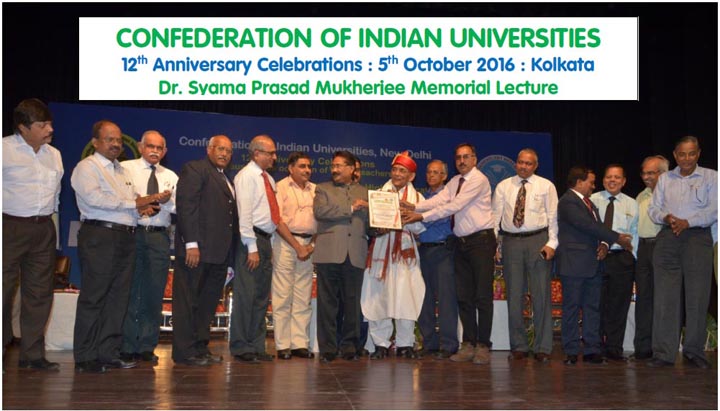
The Chancellors and Vice Chancellors being
felicitated for their outstanding
contribution
Dr. Trivedi added that the Central
Government will identify 10 Government and
10 Private Universities and help them
achieve "world-class
standards". According to the HRD
Ministry's concept note submitted to the
Prime Minister's Office, these universities
will have
-
A corpus of at least Rs 1,000 crore
-
A place in the top 500 in any renowned
ranking system
-
Accreditation by a reputed international
agency
-
Faculty-student ratio not less than 1:10
over 3 years of establishment
-
Excellent laboratory facilities and
cutting edge research
-
A good mix of domestic and foreign
students
-
A good proportion of foreign or
foreign-qualified faculty
-
Teaching and research collaborations
with reputed international universities
-
At least two publications in each
discipline in a reputed peer-reviewed
journal every year
Dr. Priya Ranjan Trivedi further added that
this proposal is similar to Universities for
Research and Innovation Bill 2012, which too
sought to create a separate category of
universities with autonomy to determine
their own standards and decide on matters
like faculty hiring and salaries,
curriculum, fees, etc.
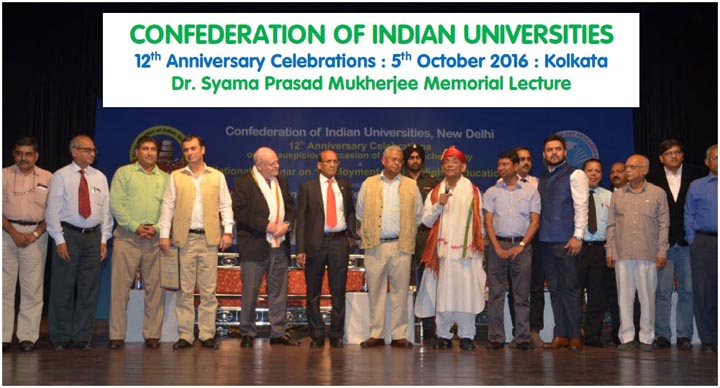
The Chancellors and Vice Chancellors having
a group photograph with the Chief Guest
Hon'ble Shri Tathagata Roy, Governor of
Tripura, Hon"ble Mr.
Olaf
Iversen, Consul General
of Germany in Kolkata and CIU President
IAEWP State Chancellor for Delhi Dr. P R
Trivedi
Discussing and explaining the modalities of
the selection of these Universities out of
the existing inventory of more than 875
university level institution including the
Central, State, Deemed and Privately Funded
Universities besides the Institutions of
National Importance, Dr. Trivedi said that
the aspirant institutions will submit a
detailed 15-year plan of how they would meet
laid-down requirements of world-class
universities. A Committee of experts set up
by the UGC will evaluate the plans and pick
the universities for upgradation. Applicants
in the Government category should figure in
the top 25 of the National Institution
Ranking Framework. Those in the private
category can be both greenfield and
brownfield institutions. Brownfields must be
deemed universities with an 'A' from NAAC;
greenfields must have a corpus of Rs. 750
crore.
Elaborating the cooperation and support from
the Government, Dr. Trivedi said that the
institutions will be able to:
-
Charge fees from foreign students
without restriction, and determine fee
for domestic students, provided no
meritorious candidate is turned away for
want of money. There should be adequate
scholarships.
-
Offer courses and degrees in new areas
without consulting regulatory
institutions.
-
Initiate academic collaborations with
foreign educational institutions without
need for Government approvals.
-
Hire foreign faculty with relaxed salary
restrictions.
-
Hire industry experts even if they don't
have requisite academic qualification.
-
Spend resources with full financial
autonomy.
-
Government world-class universities will
get additional assistance of Rs. 500
crore over 5 years.
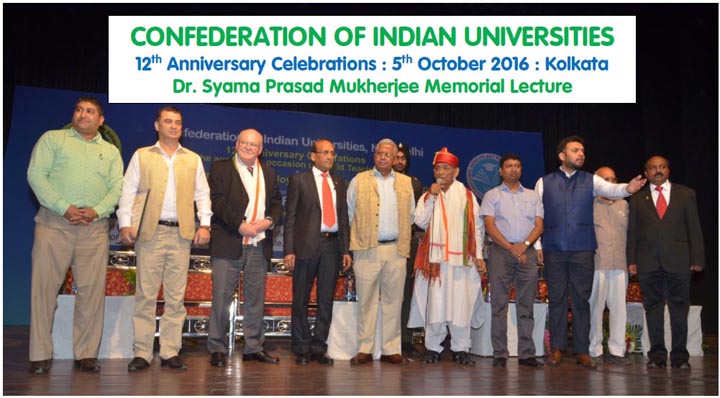
The Chancellors and Vice Chancellors having
a group photograph with the Chief Guest
Hon'ble Shri Tathagata Roy, Governor of
Tripura, Hon'ble Mr.
Olaf
Iversen, Consul General
of Germany in Kolkata, the CIU President
IAEWP State Chancellor for Delhi Dr. P R
Trivedi and the
Organizing Committee Heads
for the 12th
Anniversary Celebrations on 5th
October 2016.
Examining the prospects and the constraints,
Dr. Trivedi commented that the details of
the proposal are not public, and have not
been analyzed threadbare. Allowing private
players to set up entirely new institutions
as world-class universities could be seen as
an attempt to give big private interests
easy passage into the education sector with
little monitoring, and without the
obligation of adhering to Government
regulations. The proposal is silent on
whether foreign education providers can use
this route to enter India and set up
campuses here.
Gassing the future scope and possibilities,
Dr. Trivedi said that a law can be brought
by Parliament, or such institutions can be
declared Deemed Universities. Should the HRD
Ministry choose the Deemed University route,
the University Grants Commission will have
to amend its Deemed University Regulations.
Dr. Trivedi congratulated the Central
Government for recently announcing the
desire to have 20 Universities that are
ranked among the world's great universities.
Although that goal is praiseworthy, the
ability to make the dream a reality seems
far-fetched based on my experiences over the
past year doing research on higher education
in India.
Dr. Trivedi also observed that regardless of
which rankings one considers, a glut of
universities in the United States always
appear in the top 200. By one measure, eight
of the top 10 and 50 of the top 100
universities in the world are from the US.
The result is that other countries try to
mimic what they think the Americans are
doing, but they learn the wrong lessons.
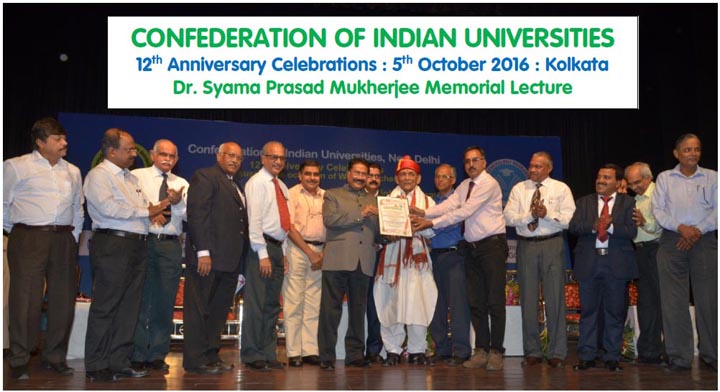
The Chancellors and Vice Chancellors being
felicitated for their outstanding
contribution in the
specialized
areas related to educational
planning, administration, research and
development
India's plan is to have half
of the 20 world-class universities come from
the private sector. The assumption seems to
be that private universities are among
America's best institutions and that the
small number of new privates in India might
be better situated to vault into the elite
200 than the many older central and State
Universities.
The US Government also does
not fully fund all of its public
universities; that is music to the ears of
Indian politicians who want to use public
monies for other public services.
Such an interpretation of
America's dominance in world-class rankings
is a misreading of why American universities
continue to dominate league tables. Here are
five ways to think about American higher
education that may be useful for helping
India achieve its goals :
World-class universities are
old: Of the top 200 universities in the
world only one is less than 50 years old. A
handful of US universities are just over 50
years old, but most have been around for
much longer. However admirable some of
India's new private universities are, there
is almost no chance that any will leap into
the top 200 in the next decade - and
certainly 10 private universities won't. If
India wants to break into the upper echelon
within 10 years it will be done by public
universities or not at all.
-
World-class universities
have strong vice-chancellors without
term limits: Public and private
universities in the US have
vice-chancellors who are largely chosen
because of their fundraising and
intellectual prowess. They generally do
not serve with term limits and are not
political appointees. At my own
University of Southern California, I
have had two presidents in 22 years. The
Board of Trustees, with faculty input,
hired them. My current president is
raising US$7 billion over 10 years to
strengthen our endowment. India's
vice-chancellors serve very short terms,
are often political appointees, and
almost never raise significant amounts
of capital from donors and
philanthropists.
-
World-class universities
have institutional autonomy: Strategic
plans, hiring and tenure determinations
and budgeting decisions are made by the
faculty and administrators of America's
best institutions. Deans and faculty
researchers have a significant amount of
authority over their budgets. In India
the ministry and the University Grants
Commission exert enormous oversight that
disables any sense of institutional or
individual autonomy.
-
World-class universities
have significant discussions about
academic quality: The standards for
tenure and promotion at premier American
universities continue to rise. The
determination of the standards is set,
and quality control is carried out, by
the faculty. Tenure is a process that
ensures faculty rights, but also
requires faculty responsibilities. In
India, discussions about quality, if
they occur, take place on national
commissions, not within a university,
and faculty appointments are seen as
government sinecures for life.
-
World-class universities
see academic freedom as the central
value of academic life: Academic freedom
is always debated and arguments about
the limits of academic freedom have
swirled on American campuses for a
century. The general precept is that
faculty, through the protection of
tenure, has an obligation to ensure that
a university's faculty and students are
able to speak what they desire, however
controversial those statements may be.
In India, academic freedom is questioned
by individuals inside and outside the
university and a chill on free speech on
campus is evident.
Dr. Trivedi suggested that if
India wishes to have a handful of
world-class universities created within the
next decade then we will have to ensure that
public funding and philanthropic support
increase. We can't say we want academic
excellence and hamstring vice-chancellors or
micro-manage from ministry offices or
overlook issues of quality control or create
a climate where academics are unable to
speak truth to power.
Dr. Trivedi emphasized that
India certainly has the intellectual
capacity to have dominant universities, but
significant structural reforms are necessary
if that promise is to become a reality. In
an increasingly globalized world, the
picture of the tranquil university steeped
in quaint intellectual pursuits and buffered
from real-world concerns appears to be
rapidly fading. Institutes of higher
learning seem to be shedding the "ivory
tower" image and embracing a vision of
well-oiled engines of research that promote
economic growth, Dr. Trivedi felt.
Dr. Trivedi also observed
that the proposed World Class Universities
are now commonly viewed as vital to advance
a nation's development, there is an urgent
need for conventional wisdom to be
scrutinized. Too many countries believe that
if they don't expand in this regard, they
won't be taken seriously on the world stage.
The notion of the world-class university has
taken on a life of its own.
Explaining the scope of world
class, Dr. Trivedi wanted to ask as to what
does "world class" really mean? He observed
that for some it means being a superpower in
terms of science and technology research. It
is connected to the idea that universities
are going to produce technological
innovations.
Dr. Trivedi also stressed the
need for research assessing the extent to
which professional development currently
taking place in universities in fact leads
to greater empowerment for students and
faculty. The trend to produce world-class
universities, to my mind, represents neither
pure progress nor pure wickedness, with the
'bad guys' taking over. The bottom line is
that countries and universities need to
think carefully and pay attention to what
theyare doing, rather than just
automatically following the pack.
Assuring the 50+ Vice
Chancellors present in the 12th
Anniversary Celebrations of the
Confederation of Indian Universities held at
the Science City Auditorium, Kolkata on 5th
October 2016 on the occasion of the World
Teachers' Day where the Chief Guest was the
Hon'ble Governor of Tripura Prof. Tathagata
Roy who also assured of his fullest
cooperation for strengthening the cause of
CIU for enabling the university level
institutions to become world class. While
inaugurating the 12th
Anniversary Celebrations of CIU and
releasing "The Indian Universities Directory
2016", the Governor Prof. Tathagata Roy
recalled the outstanding contribution of CIU
in uniting all the Universities of India and
by implementing action oriented programmes
not presently covered by the University
Grants Commission (UGC) and the Association
of Indian Universities (AIU).
While reciprocating the plan
envisaged by CIU, Chancellor Dr. P R Trivedi
announced that Tripura will be the priority
State for implementing cleanliness, hygiene
and sanitation education for making Tripura
as a model State.
It may be mentioned that the
Confederation of Indian Universities (CIU)
under the dynamic leadership of the great
institution builder, philanthropist, thinker
and environmental scientist Chancellor Dr.
Priya Ranjan Trivedi has designed a
masterplan paradigm for helping all the 875+
university level institutions to optimize
their available resources and for greening
and cleaning their ivory tower and for
ensuring proper skill development with a
view to producing more number of job givers
rather than job seekers for ultimately
solving the burning problems relating to
peacelessness, poverty, unemployment, greed,
pollution, faulty educational system and
population explosion.
Dr. Priya Ranjan Trivedi has also invited
all the educational planners, thinkers and
administrators to keep on contacting him and
the CIU Team through his Email ID :
[email protected]
|
|
Darbhanga, dated 5 November 2016 |
Book on Darbhanga released by Chancellor Dr.P. R.
Trivedi for promoting mithila culture on the world
map |
|
Releasing the bilingual Book titled "Darbhanga :
Past, Present and Future" in the Gandhi Sadan, the
official Guest House of Lalit Narayan Mithila
University, Chancellor Dr. Priya Ranjan Trivedi,
President and Plenipotentiary of the Confederation
of Indian Universities (CIU) said that through this
unique Book, the cultural heritage of Mithila region
will be brought on the world map. Dr. Trivedi
further added that the entire District of Darbhanga
will be optimally developed with the help of all the
329 Panchayats and 1269 Villages by associating the
local Schools, Colleges and Universities with a view
to ensuring urgent solutions of the problems
including unemployment, peacelessness, poverty etc.
by providing skill based training in general and
cleanliness, hygiene and sanitation education in
particular.

The President and Plenipotentiary of the
Confederation of Indian Universities (CIU) releasing
the Book
titled "Darbhanga : Past, Present and
Future" at 10.30 am on 5th November 2016
at Gandhi Sadan,
L N Mithila University, Darbhanga
in the presence of the Acting Vice Chancellor
of LNMU
Prof. Ram Chandra Thakur, Former Vice
Chancellor of Rajendra Agricultural University Prof. Gopalji Trivedi,
Registrar of LNMU Dr. Ajit Kumar
Singh, Maharajadhiraj Sir Kameshwar Singh Chair
Dr. Vinod Kumar Chaudhary and PIO of LNMU Dr. N.K.
Agrawal.
While recalling the history of Darbhanga, the great
institution builder and environmental scientist Dr.
Priya Ranjan Trivedi further added that
Darbhangā
is
5th largest city of Bihar
and rapidly developing. Darbhanga is also the second
biggest medical hub of Bihar. The history of
Darbhanga dates back to the
Ramayana
and
Mahabharata
periods; it is among the oldest cities of Bihar.
According to the
Vedic
sources, the
Videhas
first migrated to the area from the banks of
Saraswati
in
Punjab;
they were guided to the east of Sadanira (Gandak
River) by
Agni,
the God of Fire. Settlements were established and,
thus, flourished the kingdom of the
Videhas,
the Selfless. In the course of time, Videhas came to
be ruled by a line of kings called
Janaks.
In this line of kings, there was a very famous king
named Mithi. To commemorate his greatness the
territory was named as
Mithila.
Another famous king was Janak Sirdhwaja, father of
Sita.
The legends speak of various learned men patronized
by Janak Sirdhwaja, who himself was an erudite
scholar. Prominent among them were
Yagyavalkya,
who codified the Hindu law in his Yagyavalkya Smriti
and Gautam, who had various valuable philosophical
treatises to his credit. King Janak was himself a
great philosopher and his ideas have been eternally
enshrined in the Upanishads, especially in the
Brihad-āraṇyaka
Upaniṣada.

The President and Plenipotentiary of the
Confederation of Indian Universities (CIU) releasing
the Book titled
"Darbhanga : Past, Present and
Future" at 10.30 am on 5th November 2016
at Gandhi Sadan,
L N Mithila University, Darbhanga
in the presence of the Acting Vice Chancellor
of LNMU
Prof. Ram Chandra Thakur, Former Vice
Chancellor of Rajendra Agricultural University Prof.
Gopalji Trivedi,
Registrar of LNMU Dr. Ajit Kumar
Singh, Director of the National Institute of
Cleanliness Education and Research
(NICER) Dr. Utkarsh Sharma, Maharajadhiraj Sir Kameshwar Singh
Chair Dr. Vinod Kumar Chaudhary
and PIO of LNMU Dr.
N.K. Agrawal.
He also mentioned that the name Darbhanga is the
mutated form of "Dwarbanga". That is, it is the
combination of words "Dwar" (Gate) and "Banga"
(Bengal) meaning "Gateway of Bengal". If one notices
Bengali and Maithili, he will find many a phonetic
similarities particularly in the main verbs of both
the languages which ends with word sounding "Chhe".
He was also quoting the views of some scholars that
Darbhanga was named after Dar (Dwar) and Bhangaa
which means broken gates. It is assumed that the
gates of the Qila (at Qilaghat probably) were broken
(by cannons or elephants) in 1326 AD when Tughlak
forces attacked the last independent North Indian
Hindu king.
Further elaborating the past history and glory of
Darbhanga, Dr. Trivedi explained that according to
Imperial Gazetteer of India Vol 11 Page 158 "The
Darbhanga family traces its origin to one Mahes
Thakur, who is said to have come from Jubbulpore
about; the beginning of the sixteenth century. He
took service as a priest with the descendants of :
Raja Siva Singh, who still exercised a nominal
supremacy in Tirhut; but when they collapsed before
the advancing Muhammadan power, Mahes Thakur induced
Akbar to grant him what are now the Darbhanga Raj
estates. He and his descendants gradually
consolidated the power of the family in both
agrarian and social matters; and though, owing to
recusancy at the Permanent Settlement, the Raja of
that period was for some time deprived of a portion
of his property, the British Government eventually
recognized him. During the first half of the
nineteenth century, owing to mismanagement and
litigation, the estate fell into considerable
difficulties. But the litigation had the effect of
deciding that the estate was impartible and that the
inheritance to it was regulated by primo- geniture;
and owing to a long minority of over twenty years
from x860 onwards, during which the estate was under
the Court of Wards, it is now in a very flourishing
condition. Darbhanga town has been the headquarters
of the family since 1762, prior to which date they
re- sided at Madhubaru. The present Maharaja
Bahadur, Sir Rameswar Singh, K.C.I.E., succeeded on
the death of his brother in 1898. The estates at
present comprise lands situated in the Districts of
Darbhanga, Muzaffarpur, Gaya, Monghyr, Purnea, and
Bhagalpur, with a total area of more than 2,410
square miles".
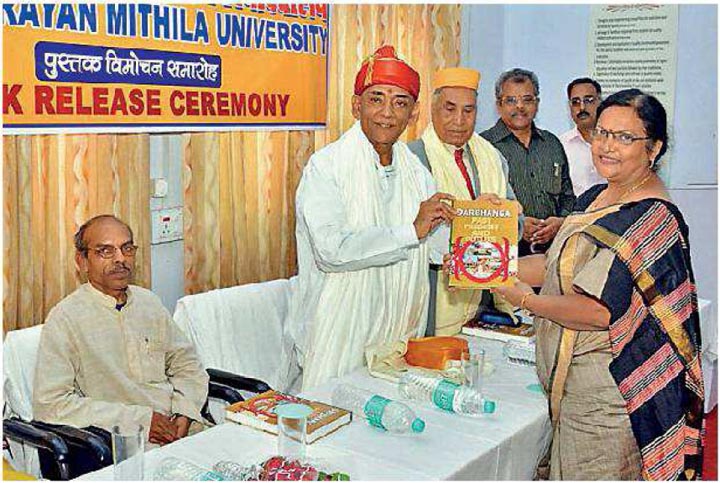
Member of the Editorial and Compilation Team for
bringing out the Book on Darbhanga,
Dr. Saroj
Chaudhary, Assistant Professor of Sociology, LNMU
receiving the first copy of the Book
from the Chief
Guest and President of the Confederation of Indian
Universities Dr. Priya Ranjan Trivedi.
Stressing the need for restoring the ancient
cultural heritage of Mithilanchal, Dr. Trivedi said
that in the thirteenth century Mithila was invaded
by Afghans, who deposed the Kshatriya ruler and
placed a Maithil Brahman in control of land revenues
over much of this region. This family soon began
calling themselves kings, distributing land to other
members of their caste, so that gradually land
passed into the control of Maithil Brahmans. It was
taken by the Turks in the 14th century. During
Akbar's reign in the sixteenth century, a second
Maithil Brahman family came to rule as the
Khandavala Dynasty.
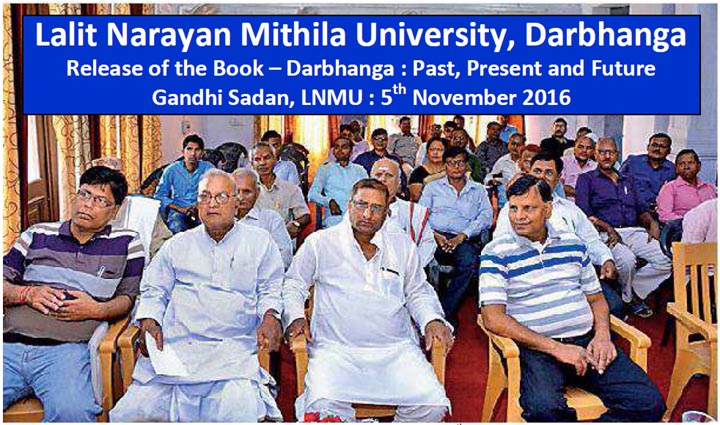
Special Invitees attending the Book Release Function
on 5th November 2016 at Darbhanga.
It enjoyed stability under the Mughals and Hindus
began to flock to this town since the beginning of
the 19th century when the Maharaja of Darbhanga
shifted his residence to the town and was granted
the title Maharaja by the
East India Company.
It was the biggest town of North Bihar for
centuries, but after
Muzaffarpur
was connected to broad-gauge railway in the
mid-1970s, the latter overtook Darbhanga due to
shift of trade, commerce, business and transport to
some extent.
During
Akbar's
reign in the sixteenth century, a second Maithil
Brahmin family came to rule as the Khandavala
Dynasty. During this period, Akbar also planted
100,000 mango trees in Darbhanga, at a place now
known as Lakhi Bagh. In British times, their estate,
Darbhanga Raj, was the largest and richest of the
great zamindari estates. Their capital was in Bhaur
village in
Madhubani,
later shifted to the town of Darbhanga. They
controlled most of Mithila until after Independence
when the Republic of India abolished zamindari
(Maharaja of Darbhanga was actually a zamindar
entitled to add the title Maharaja in his name,
besides the British title: KCIE (Knight Commander of
Most Eminent Order of the Indian Empire).
The Maharaja of Darbhanga, Sir Kameshwar Singh, was
also an integral part of the Constituent Assembly of
India and was instrumental in campaigning for
retention of privy purses and land rights for
rulers. He single handedly negotiated rights of
various rulers and nawabs.
Maharaja of Darbhanga also spent much time in
today's called kolkata, Bengal. It can be seen in
various places as he has built various important
places for Bengal, as in Calcutta University
Building is "Darbhanga Building" Dalhousie Square
and various important buildings there is also made
by him. He has made great contributions to Bengal
and Indian education and society.
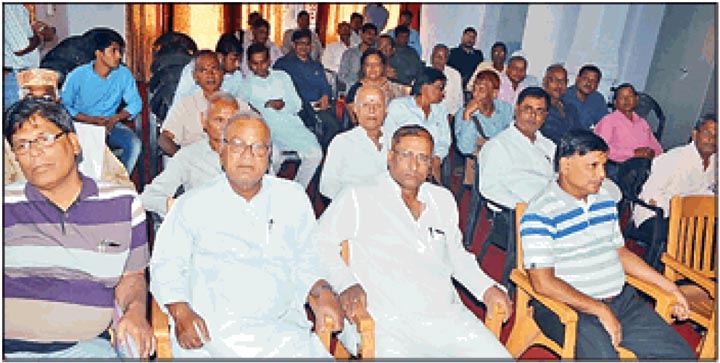
A view of the important personalities and invitees
attending the Book Release Function at 10.30 am
on 5th
November 2016 at Gandhi Sadan, LNMU, Darbhanga.
The main languages spoken in this district are
Maithili,
Hindi,
Urdu,
however
Hindi
is used for official documentation. Here,
Urdu
is spoken by locale Muslim community in a unique
style. In Darbhanga City, local residents speak a
relaxed style of Maithili. Other languages spoken by
their respective speakers in Darbhanga are Bajjika,
Bengali, Marwari, Punjabi and Sindhi.
Dr. Trivedi urgently felt the need for restoring the
important historical places of Darbhanga like the
Raj Fort, the Queen Palace, the Darbhanga Musuem,
the Shayama Mandir, the Jama Masjid and all the
Lakes and Ponds.
As per data released by the government of India for
the 2011 census, Darbhanga is an Urban Agglomeration
coming under category of Class I UAs/Towns. The
total population of Darbhanga UA/Metropolitan region
is 306,089. The male population of which is 161,346
while female population is 144,743. Total literates:
205,203. Male literates: 115,620. Female literates:
89,583. Sex ratio: 898, Child sex ratio: (0-6 years)
905 and Effective Literacy State rate (7+ Pop):
total Persons: 80.88, Male: 86.43, Female: 74.68,
Compare to 2001 India census, Darbhanga City had a
population of 267,348 while the district had a
population of 3,295,789. Males constitute 52% of the
population and females 48%. Darbhanga has an average
literacy rate of 64%, which is higher than the
national average of 59.5%: male literacy is 72% and,
female literacy is 56%. In Darbhanga, 15% of the
population is under 6 years of age. Darbhanga is a
place where people of different languages and
religions live. There are many lingual minorities
which have contributed to the development of
Darbhanga.
Darbhanga has a
humid subtropical climate
(Koppen
climate classification
Cwa).
Darbhanga is located in the northern part of
Bihar.
Darbhanga is well connected via rail and road
services.
Darbhanga Junction
is one of the oldest Railhead of North Bihar, It's a
A1 category railway junction and a model station on
the
East Central Railway
and is one of the highest earning most important
railway junction in zone and in state, Darbhanga is
the busiest station of Samastipur Division as it is
connected directly to all the major cities of
India,
viz.,
Kolkata,
Delhi,
Bangalore,
Mumbai,
Amritsar,
Patna,
Nagpur,
Kanpur,
Ranchi,
Pune,
Guwahati,
Bhubaneshwar,
Ahmedabad,
Hyderabad,
Chennai,
Raipur,
Bilaspur,
Lucknow,
Varanasi,
Siwan,
Gorakhpur,
Guwahati,
Raxaul,
Mysore,
Ajmer
Bangaluru
etc. About the beginning of railway in Darbhanga and
it's neighboring areas The Imperial Gazetteer of
India, v. 11, p. 158/159. says: "The famine of 1874
gave a great impetus to the construction of
railways, and the District is on the whole well off
in the matter of com- munications. Its south-west
corner is traversed for . 29 miles by the main line
of the Bengal and North-Western Railway, and also by
25 miles of the new chord-line from Hajipur to
Bachwara, which runs parallel to the Ganges
embankment from east to west. From Samastipur a line
runs to Darbhanga town and there branches off in two
directions, the first north-west to Sitamarhi
through Kamtaul and Jogiara, and the other due east
to Khanwa Ghat on the Kosi (Old streem) near
Pratapganj. The total length of the line within the
District is 146 miles. Most of the earthwork for a
line from Sakri to Jaynagar on the Nepal frontier
was completed as a relief work during the famine of
1897 ; and the line, which has now been opened,
should tap a large grain supply from Nepal". The
Darbhanga Junction connects very large part of North
Bihar and Tarai of Nepal with rest of India as major
Rail head. It is the main station of Darbhanga and
Madhubani.
Darbhanga is connected to other parts of India by
National Highway 57
, National Highway 105 and
Bihar State highways
50, 56, 88 and 75. Darbhanga is also connected to
the
Madhubani
which is located at Nepal border and
Sitamarhi.
East-West Corridor
expressway, which connects the
Porbandar,
Gujarat
to
Silchar,
Assam
passes through Darbhanga which provides greater
connectivity for trade purposes.
The city has two bus stands - Darbhanga Bus Stand
and Laheriasarai Bus Stand - and a new interstate
bus stand is under construction for the city. Bus
services are available from Darbhanga to all the
nearby major cities viz.
Patna,
Gaya,
Kolkata,
Purnia,
Bhagalpur,
Muzaffarpur,
Ranchi,
Jamshedpur.
For local transport, the commuters have the options
of city bus and auto-rickshaw.
Auto rickshaws
are the popular mode of local commuting. The City
Bus Service is also in the city by
BSRTC.Low
floor buses are also proposed for the city by
Central Govt.
Darbhanga Airport is the longest runway airport of
Bihar, and is operated by the
Indian Air Force
at present. It is spread over a 200-acre area of the
city. It was built exclusively for the use of
Maharajah of Darbhanga's
aeroplanes.
Spirit Air
started operations from Darbhanga in 2009, but was
forced to withdraw due to its smaller strip. Spirit
Air has again started its service from Darbhanga
Airport.
Darbhanga Aviations
was a private Indian airline started in 1950 by
Maharaja Kameshwar Singh of Darbhanga. It had three
aircraft and became defunct by 1962.
All India Radio
has a 20 kW medium-wave radio station in Darbhanga
which transmits various programs of mass interest
and cover a part of Noth Bihar and terai of Nepal.
Another DAS transmitter of 20 kW MW is expected to
start soon who will replace existing analog
transmitter in future.
Doordarshan
has one DD National and one DD News LPT relay
transmitters. Darbhanga still don't have FM
transmitter yet.
Further explaining the cooperation with L.N. Mithila
University, Dr. Trivedi assured the acting Vice
Chancellor Prof. Ram Chandra Thakur, the Registrar
Dr. Ajit Kumar Singh, the PIO, the Convenor of the
Book Release Function Dr. N.K. Agrawal, Dr. Vinod
Kumar Chaudhary, Head, Maharajadhiraj Kameshwar
Singh Chair on Sociology and several Heads of
Departments and the Deans of Faculties that the
proposal for the establishment of the Centre for
Nano Science and Technology will be endorsed by the
CIU and that the Encyclopaedia of Nano Science and
Technology will be presented to LNMU Library very
soon in the presence of the Vice Chancellor Prof.
Saket Kushwaha who was away to USA for signing MoU
and technical cooperation with US based universities
and other establishments.
Others who presented their views on the occasion of
the Book Release Function were Prof. Gopal Ji
Trivedi, Former Vice Chancellor, Rajendra
Agricultural University and others from LNMU
including Dr. Ajit Kumar Singh, Dr. Vinod Kumar
Chaudhary, Dr. Vaidya Nath Chaudhary, Dr. Chandra
Bhan Prasad Singh, Dr. Surendra Kumar Suman, Dr.
Muneshwar Yadav, Dr. Ram Kumar Jha, Dr. Anil Kumar
Jha, Dr. Utkarsh Sharma and Dr. Vinay Kumar
Chaudhary.
All the invitees specially the Chief Guest and the
Special Guest offered their tributes to the great
poet and writer Shri Nagarjun on the occasion of his
death anniversary by offering flowers on his statue
kept and installed in the university campus at
Darbhanga.
|
|
Muzaffarpur dated 4 November 2016 |
Book titled "Muzaffarpur : Past, Present and Future"
released by the MLAs during Chhath |
|
Muzaffarpur dated 4th November 2016 the
Book titled "Muzaffarpur : Past, Present and Future"
compiled by the renowned institution builder,
management thinker, philosopher and technocrat
turned environmentalist Dr. Priya Ranjan Trivedi,
President, CIU was jointly released by the MLA of
Muzaffarpur Shri Suresh Kumar Sharma and the MLA of
Vaishali Shri Raj Kishore Singh in the august
presence of the renowned agricultural scientist
Prof. Gopalji Trivedi and the renowned linguist
Prof. Damodar Thakur.
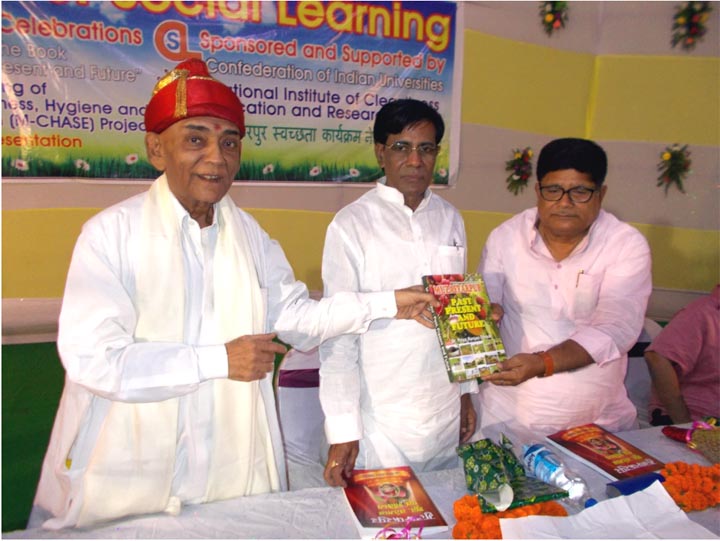
The MLA of Muzaffarpur Shri Suresh Kumar Sharma
receiving the first copy of the Book
"Muzaffarpur :
Past, Present and Future" from the Author Dr. Priya
Ranjan Trivedi in the
presence of the MLA of Vaishali Shri Raj Kishore Singh at 3 pm on 4th
November 2016
in the Amrapali Auditorium, Club Road,
Muzaffarpur.
In their inaugural address both the MLAs
congratulated and thanked Dr. Priya Ranjan Trivedi
for his outstanding contribution towards this unique
compilation for highlighting the ancient Bajji
culture of this region besides explaining the need
for conducting integrated developmental programmes
in all the 1800+ villages of Muzaffarpur District.
The MLA of Muzaffarpur, Shri Suresh Kumar Sharma was
also presented with the first copy of both English
and Hindi editions of the Book on Muzaffarpur.
The MLA of Vaishali Shri Raj Kishor Singh while
thanking Dr. Priya Ranjan Trivedi for bringing out
this unique Book also advised him for bringing out
another Book on Vaishali for which Dr. Trivedi
happilly agreed and assured the MLA that the
bilingual Book on Vaishali will be brought out soon
and that the same will be released at Vaishali in
the second week of February 2017.
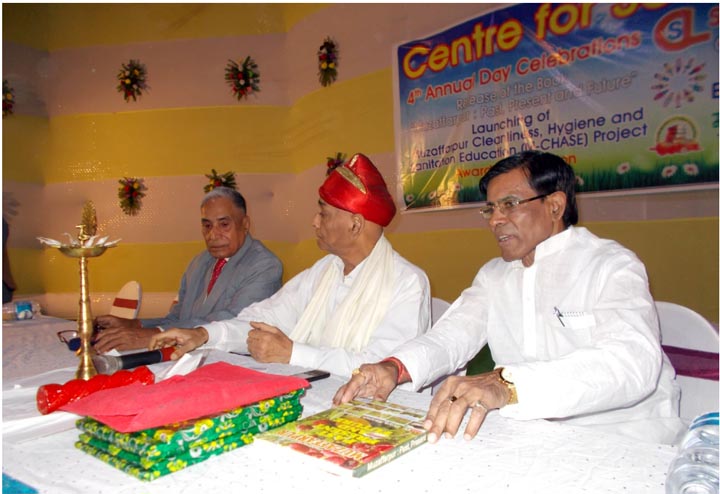
The Book launching function for the Book titled
"Muzaffarpur : Past, Present and Future"
was organised by the Central for Social Learning at
Muzaffarpur on 4th November 2016.
In the
Inaugural Session, those sitting on the dais are Dr.
P R Trivedi, Dr. Gopalji Trivedi and
the MLA of Vaishali Shri Raj Kishore Singh at the Club Road,
Amrapali Auditorium.
The Former Vice Chancellor of Rajendra Krishi
Vishwavidyalaya Prof. Gopalji Trivedi presented the
keynote address and hoped that
Dr. Priya Ranjan
Trivedi will prepare a master plan for Muzaffarpur
for solving all problems including water,
sanitation, hygiene, sewage, sewerage, traffic
congestion, pollution, law and order besides lack of
facilities in the area of skill based training.
The renowned Professor of English and the reputed
linguist Prof. Damodar Thakur hoped that Dr. Trivedi
will bring out more publications related to
Muzaffarpur and the Tirhut Division with a view to
highlighting the ancient cultural heritage of this
area besides proposing a neological and a neocratic
approach to local governance.
Discussing the features of this Book Dr. Priya
Ranjan Trivedi said that Muzaffarpur is the second
most popular and populous city after
Patna in Bihar.
Muzaffarpur, famous for Shahi lychees,
is the largest city of northern Bihar. It is
situated on the banks of the perennial Burhi
Gandak River, which flows
from the Someshwar Hills of Himalayas.
Muzaffarpur is one of the many gateways to
Nepal. Clothes and
food-grains are traded between Nepal
and Muzaffarpur.
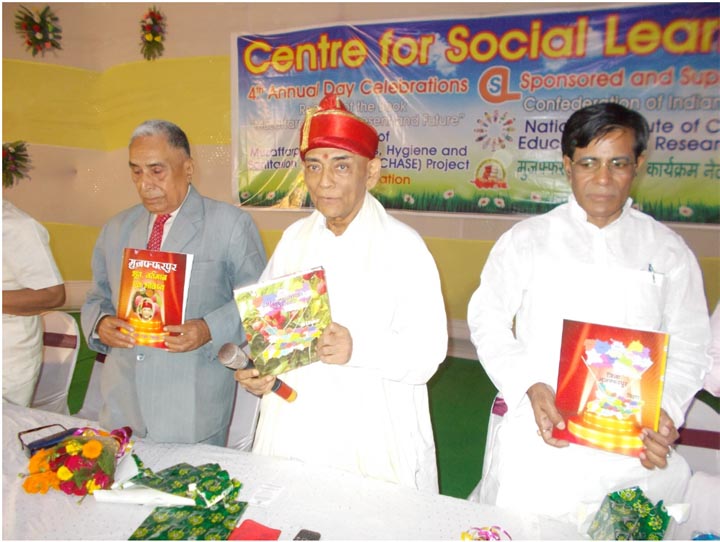
CIU President Dr. Priya Ranjan Trivedi, Vaishali MLA
Shri Raj Kishore Singh and
Renowned Agricultural
Scientist Prof. Gopalji Trivedi during the release
function.
Muzaffarpur is located at
26o07′N
85o24′E.
The city lies in a highly active
seismic
zone of India. In the disastrous earthquake
on 15 January 1934, much
of the town suffered severe damage and many lives
were lost. It has an average elevation of 47 meters
(154 feet). This saucer shaped, low-centered town
lies on the great Indo-Gangetic plains of Bihar,
over Himalayan silt and sand brought by the
glacier-fed and rain-fed meandering rivers of the
Himalayas. The soil of the town is highly fertile,
well drained and sandy, white coloured and very
soft. The landscape is green all year round. The
town is surrounded by the flood plain dotted with
ponds and oxbow lakes,
with sparkling sandy river banks and clean air and
water. Numerous private fruit orchards and idyllic
rivers are also nearby. The city has a water-table
just 20 ft. below ground level.
Muzaffarpur now is a rapidly growing city. The
unplanned growth in the last decade has been
phenomenal. Thousands of villagers migrated to this
City from nearby villages in the rapid urbanisation
of post-independence India, and this has created
serious infrastructure problem. The drainage system
and garbage disposal system is disorderly and
practically non-existent.
The downtown areas of Muzaffarpur are Tilak Maidan
Road, Kalyani and Saraiyaganj and Motijheel. These
areas are densely populated with small shops as well
as branded shops selling a plethora of goods and
services. Motijheel is the main shopping area.
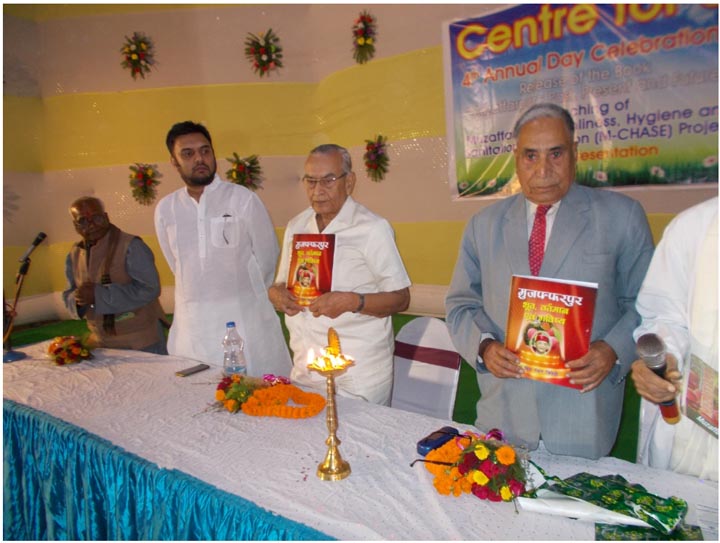
Dr. Gopalji Trivedi, Prof. Damodar Thakur, Dr.
Utkarsh Sharma and Shri Janardan Sharma
during the
Book Release Function at Muzaffarpur on 4th
November 2016.
Chakkar Maidan has a small encampment of members of
the
Territorial Army
non-departmental unit 151 Inf Bn (TA) JAT.
Muzaffarpur City has old temples like Baba Garib
Nath (Shiva
Temple) and Devi Mandir Durga,
Chaturbhuj-sthan,which has also a red light area,
Raj Rajeswar Devi Kali (Durga)build
by Darbhanga Maharaj and Kalibari, the Kali
temple. There are also Hazrat Bilal Mosque
Brahampura Data Kammal Shah Majaar Purani Bazaar,
Kothiya Shareef Kanti Several large and small places
of worship.
Muzaffarpur City was established by and named after
an Afghan Md. Muzaffar Khan, an Amil (Revenue
Officer). The District is bounded by the East
Champaran, Sitamarhi, Vaishali, Saran, Darbhanga and
Samastipur Districts. It has won international
encomiums for its delicious Shahi (Royal) and China
Lychee species.
While the history of this City is not available
fully but that of the recorded history of the
District dates back to the rise of the Vrijjan
Republic, when the center of political power shifted
from Mithila to Vaishali. The Vrijjan Republic was a
confederation of eight clans of which the Licchavis
were the most powerful and influential. Even the
powerful kingdom of Magadh had to conclude
matrimonial alliances in 519 B.C. with the
neighbouring estates of the Licchavis. Ajatshatru
invaded Vaishali and extended his sway over Tirhut.
It was at this time that Pataliputra (the modern
Patna) was founded at the village Patali on the
banks of the sacred
Ganges river, and
Ajatshatru built an invincible fortress to keep
vigil over the Licchavis on the other side of the
river. Ambarati, 40 km from Muzaffarpur is believed
to be the village home of Amrapali, the famous Royal
court dancer of Vaishali.
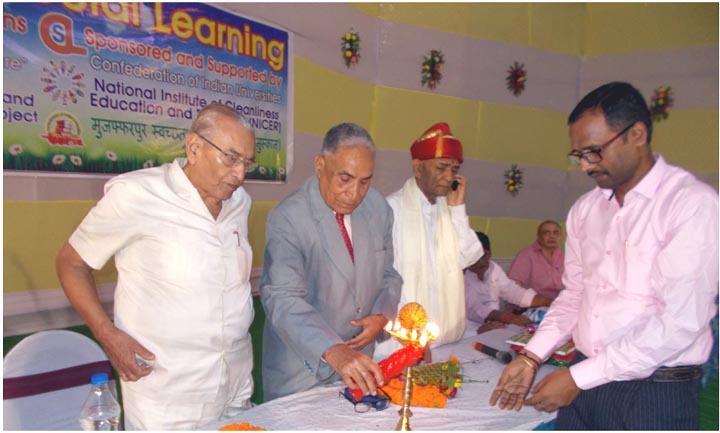
Prof. Gopalji Trivedi, Prof. Damodar Thakur,
Dr. Priya Ranjan Trivedi with the
Director
of Centre
for Social Learning Shri Rajiv Ranjan Kumar during
the lighting of lamp ceremony.
From the visit of the Hieuen Tsang until the rise of
the Pala dynasty, Muzaffarpur was under the control
of Maharaja Harsha Vardhan, a powerful sovereign of
North India. After 647 A.D. the District passed to
the local chiefs. In the 8th century A.D. the Pala
kings gained control over Tirhut and kept it until
1019 A.D.The sixty-sixth descendents of the Palas
are the Pauls in Muzaffarpur. Samiran Kumar Paul,
the eminent scholar, teacher and Poet is one of
them. Chedi kings of Central India also exercised
their influence over Tirhut until they were replaced
by the rulers of the Sena dynasty towards the close
of the 11th century.
Sometime between 1211 and 1226, Ghais-u-ddin Iwaz,
the ruler of Bengal, became the first Muslim invader
of Tirhut. However, he could not succeed in
conquering the kingdom, merely extorting tributes.
It was in 1323 that Ghiyasuddin Tughlaq established
his control over the District.
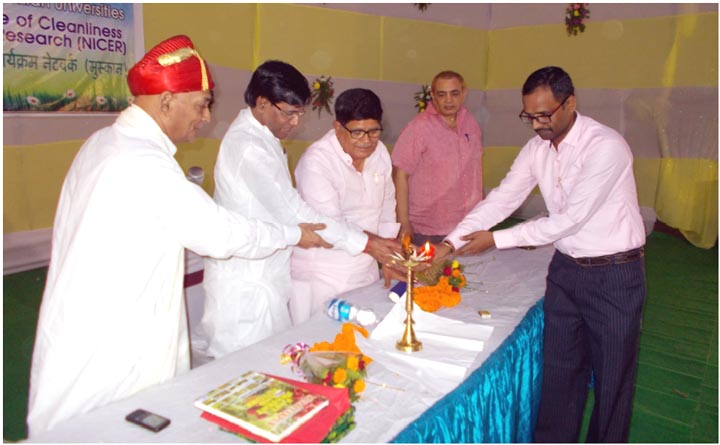
The traditional Indian Oil Lamp being lit jointly by
the Chief Guests Shri Suresh Kumar Sharma,
MLA of Muzaffarpur, Shri Raj Kishore Singh, MLA of Vaishali
in the presence of
CIU President Dr. P R Trivedi,
CSL Director, Shri Rajiv Ranjan Kumar and the
Director of
K.C. Mount Fort School Shri Rajnee
Ranjan Trivedi.
The history of Muzaffarpur would be incomplete
without a reference to the Simraon dynasty (in the
north-east part of Champaran) and its founder,
Nanyupa Deva, who extended his power over the whole
of Mithila and
Nepal. During the regime
of Harasimha Deva, the last king of the dynasty,
Tughlaq Shah invaded Tirhut in 1323 and gained
control over the territory. Tughlaq Shah handed over
the management of Tirhut to Kameshwar Thakur. Thus,
the sovereign power of Tirhut passed from the Hindu
chiefs to the Muslims.
Towards the close of the 14th century the whole of
North Bihar, including Tirhut, passed to the kings
of Jaunpur and remained under their control for
nearly a century, until Sikandar Lodi of Delhi
defeated the king of Jaunpur. Meanwhile, Hussain
Shah, the Nawab of Bengal, had become so powerful
that he exercised his control over large tracts
including Tirhut. The emperor of Delhi advanced
against Hussain Shah in 1499 and got control over
Tirhut after defeating its Raja. The power of the
Nawabs of Bengal began to wane and, with the decline
and fall of Mahood Shah, north Bihar formed a part
of the mighty Mughal Empire. Though Muzaffarpur with
the entire north Bihar had been annexed, the petty
chieftains continued to exercise effective control
over this area until the days of Daud Khan, the
Nawab of Bengal. Daud Khan had his stronghold at
Patna and Hajipur, and after his fall, a separate
Subah of Bihar was constituted under the Mughal
dynasty, with Tirhut forming a part of it.
The victory of East India Company in 1764 at the
battle of Buxar gave them
control over the whole of Bihar and they succeeded
in subduing the entire District.The British India
Association gives glimpses of part of the British
period. The success of the insurgency in Delhi in
1857 caused grave concern to the English inhabitants
in this District and revolutionary fervor began to
permeate the entire District. Muzaffarpur played its
role and was the site of the famous bombing case of
1908. The young Bengali revolutionary,
Khudiram Bose, a boy of
barely 18 years, was hanged for throwing the bomb at
the carriage of Pringle Kennedy, who was mistaken
for Kingsford, the District Judge of Muzaffarpur.
After independence, a memorial to this young
revolutionary patriot was constructed at
Muzaffarpur, which still stands. The political
awakening in the country after the First
World War
stimulated nationalist movement in Muzaffarpur
District as well. The visit of Mahatma Gandhi
first time in Bihar to the house of Pt. Ambika Datta
Sharma in village Gyanpur, now Bhojpur on the Ninth
April 1917 when Pandit Sharma along with some other
persons lead the Mahatma to Acharya J.B. Kriplani,
professor of GBB College, Muzaffarpur. This was the
first visit of Mahatma MK Gandhi in Muzaffarpur on
the 10th. April 1917; next he visited Muzaffarpur in
December 1920 and again in January 1927 had
tremendous political effect in arousing the latent
feelings of the people and the District continued to
play a prominent role in the country's struggle for
freedom.
Muzaffarpur played a very significant role in the
history of North-Eastern India. The peculiarity of
Muzaffarpur in Indian civilisation arises out of its
position on the frontier line between two most
vibrant spiritual influences. To this day, it is a
meeting place of Hindu and Islamic culture and
thoughts.
All sorts of modified institutions, representing
mutual assimilation, rise along this border line. It
has undoubtedly been this highly diversified element
within her boundaries that has so often made
Muzaffarpur the birthplace of geniuses.
In January 1934, a colossal 8.1 magnitude
earthquake struck the
area, completely demolishing part of the city. The
region was shaken strongly again in the 1988
Bihar earthquake.
The summer, between April and June, is extremely hot
and humid (28/40oC,90%
Max.) and winter is pleasantly cool, around 06/20oC.
The air pollution is lower than in other areas, so
the air is comparatively clean. The best months to
visit are October through March. It is best to avoid
visits in the summer and the monsoon season (Mid
June to September) due to the heat, and heavy rains
in the District.
Muzaffarpur is the largest commercial tax payer in
Bihar after Patna.It is famous for exporting
lychee. Long ago, the
area was famous for hand-woven textiles,
sugar cane, and other
products. The District has a few sugar mills, which
are now old and dilapidated. It is the commercial
hub of North Bihar and the wholesale market of
Mumbai,
Surat and
Ahmedabad. Textile mills
in the famous Marwari
community dominate Suta Patti. The commercial hub of
the City is Motijheel, Kalyani Chowk, Purani Bazaar,
SarriyaGanj, Jawaharlal Road, Harisabha Chowk, Bela
Industrial Area, Club Road, Islampur, Shafi Daudi
Market, Andi Gola, Chata Bazar, Company Bagh, Tilak
Maidan Road, Juran Chapra, Bank Road, Mithanpura,
Aam Gola & Many more.
The land use around Muzaffarpur is mainly
agricultural and horticultural. While litchee and
mangoes are abundantly grown, principal crops are
rice, wheat, pulses, jute, maize and oil seeds.
Vegetables like cauliflower, cabbage, onion, tomato,
radish, carrot, beetroot, among others, are also
grown. Sugar cane, potato and barley are some of the
non-cereal crops grown.
The main livestock of the town are cattle, buffalo,
goats, and poultry.
Muzaffarpur City has several industries, big and
small. The railway wagon industry is one of the City
landmarks. Muzaffarpur is an important centre for
the wholesale cloth trade.
Bihar has emerged as brewery hub with major domestic
and foreign firms setting up production units in the
State.
Vijay Mallya's group,
United Breweries Group,
is setting up a production unit to make
litchi-flavoured wine, in Muzaffarpur in 2012. The
company has leased litchi gardens. Real
estate is also a part of
muzaffarpurs economy.As muzaffarpur is the most
responding and preferred area after patna.
The
litchi
crop, which is available from May to June, is mainly
cultivated in the Districts of Muzaffarpur and
surrounding Districts, in an area of about 25,800
hectare producing about 300,000 tonnes every year.
Lychee is exported to big cities like Bombay,
Kolkata and to other countries. India's share in the
world litchi market amounts to less than 1%. The
names of the litchi produced in Muzaffarpur are
Shahi and China. The fruits are known for excellent
aroma and quality.
As of the 2011 India census, Muzaffarpur had a
population of 4,22,670. Males constituted
52.96%(218,509) of the population and females
47.04%(1,90,215). Muzaffarpur had a literacy rate of
85.07%. Male literacy was 88.77%, and female
literacy was 80.91%. Seventeen percent of the
population was under 6 years of age. Being as the
hub of Bajjikanchal (Western
Mithila), Vajjika
is spoken by the natives of the District. However,
Hindi is the
language used for official documentation. Urdu is
the second official language. It is dialect of
Maithili and belongs to western part of Mithila
region.
There is no specific, authentic and purely
Muzaffarpur cuisine as such most of the cuisine can
at best be termed as
Bihari Cuisine The basic
ingredients are rice, wheat flour,
lentils(green and
yellow), root and leafy vegetables, Indian
spices, ground nut oil,
Mustard seed oil, ghee,
sugar and jaggery,
among others. The traditional breakfast includes [(
"Chura-Dahi and Chini", "Flattened Rice, Curd and
Sugar")] is one of the most popular break fast
combination of Bajjika area equally popular both
among urban and rural population being most hygienic
and ready made, jalebi,
poori,
Samosa or potato
Curry served hot with any
of a variety of Chutney
and finished with Milk Tea.
Indian-Chinese dishes such as noodles, Tandoori
dishes and South Indian like Dosa, Idaly dishes are
also eaten. Some of the ethnic cuisine and special
dishes like Thekua, Purukia, Tilkut, Tarua,
Dhaknesar, etc. are cooked during festivals,
religious functions and marriages. In modern
Muzaffarpur, ethnic cuisines find place with the
oily, hot and spicy foods of the Pan-Indian type.
Toddy
(Taari) is a fermented juice of the
Palm tree which has about
5%–8% alcohol and is very popular as "Poor Man's
Beer" in Muzaffarpur. A variety of spicy dry, baked,
fried, deep fried or curried Mutton,
chicken, fish and shellfish
are prepared and eaten. Mughalai and a few
Continental dishes, such
as Macaroni or
Spaghetti, duly
Indianised, are home cooked and relished by some
people. Pre- and post-dinner Betel nut
(Paan) chewing is very popular, along with chewing
tobacco.
Muzaffarpur Railway Station
is a major railway junction, with two suburban
stations, Ram Dayalu Nagar
and Narayanpur Anant (Sherpur).
It is served by over 43 pairs of trains each day and
virtually all major Indian cities and towns are
connected by daily or weekly trains. Within Bihar,
it is well connected to cities like Bagaha,
Narkatiaganj,
Bettiah,
Raxaul, Motihari,
Sitamarhi,
Darbhanga,
Jaynagar,
Samastipur,
Hajipur, Chhapra,
Siwan,
Saharsa, Barauni,
Begusarai,
Khagaria,
Naugachia, Katihar,
Kishanganj,
Patna, Bhagalpur
and Munger. It is
also very well connected to most major railway
junctions in neighboring Uttar Pradesh, Jharkhand
and West Bengal.
To
Delhi
there are 69 weekly connections, and to
Kolkata 62. There are
also daily (or multiple daily) trains to
Amritsar, Ludhiana,
Jalandhar,
Ambala, Agra,
Kanpur,
Bareilly,
Moradabad,
Saharanpur,
Lucknow, Allahabad,
Varanasi,
Gorakhpur, Jhansi,
Gwalior,
Jabalpur, Katni,
Satna,
Bikaner, Jaipur,
Mumbai,
Gondia, Raipur,
Ranchi,
Dhanbad, Tatanagar,
Asansol,
Durgapur,
Jalpaiguri,
Siliguri, Cooch
Behar, Guwahati,
Tinsukia,
Dimapur and many other
stations.
Direct multiple weekly or weekly trains are
available for
Jammu, Chandigarh,
Dehradun,
Ajmer, Udaipur,
Bhopal,
Pune, Nagpur,
Ahmedabad,
Surat, Valsad,
Porbandar,
Rourkela,
Sambalpur,
Bhubaneswar, Puri,
Dibrugarh,
Hyderabad,
Vijayawada,
Vishakapatnam,
Bangalore, Mysore,
Palakkad,
Ernakulam,
Coimbatore, Erode,
Chennai and many
other stations. Local and inter-state buses start
from Imli Chatti and Bairiya Bus Station. The
airport, Muzaffarpur Airport,
had regular flights to some cities but does not
operate any commercial flights now. National
Highway 57 comes via
Gorakhpur,
Motihari and crosses
Muzaffarpur and National Highway 57 via Purana Staff
Line Hotel, Etwarpur Taaj goes to Darbhanga,
Purnia. The
east-west corridor crosses Muzaffarpur thus
connecting it to all the major towns and cities in
India. The
National Highway 77
starting from Hajipur
passes through Muzaffarpur and connects Muzaffarpur
to Sitamarhi.
Recently, the National Highway 102
has been constructed which connects Muzaffarpur to
Chhapra. The
National Highway 28
connects Muzaffarpur to Barauni.
All 6 National Highways having junction here.
Currently, a Ring Road
is under construction all around Muzaffarpur and a
new bridge over Burhi Gandak river. Bus,
Taxi,
Rickshaw, Auto Rickshaws,
etc. are used for local transportation.
Muzaffarpur has an
All India Radio Rely
station known as Akashvani Muzaffarpur. It
broadcasts on FM frequencies.
Muzaffarpur is the second leading centre of
education in
Bihar after Patna.
It has a medical and an engineering college, and has
one of the oldest universities of Bihar (Bihar
University, now known as B. R. Ambedkar Bihar
University). The first
president of the Indian Republic, Dr Rajendra
Prasad was a teacher in
the Langat Singh College, Muzaffarpur.Initially
headquarters of Bihar University was at Patna.People
of Muzaffarpur demanded to shift its HQ to
Muzaffarpur.A steering committee was formed to
achieve this goal with Dr.Maghfoor Ahmad Ajaz
as convenor and Acharya J.B.Kripalani,Ashok Mehta,
Mahamaya Pd.Mahesh Pd.Sinha and others as members.
Peoples movement succeeded and UGC directed Bihar
Govt. to shift HQ of BU to MUzaffarpur
Muzaffarpur town has a small museum namely Ram
Chandra Sahi Museum.
The Book Release Function was attended by more than
100 intellectuals from Muzaffarpur and the adjoining
areas. At the outset Shri Rajiv Ranjan Kumar,
Director, CSL welcome the Guests and at the end the
Director of NICER Dr. Utkarsh Sharma proposed a
hearty vote of thanks.
|
|
|
|
|
